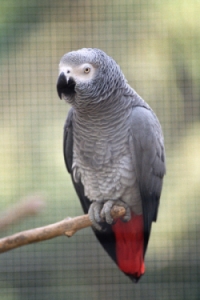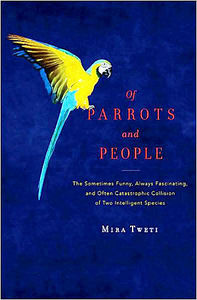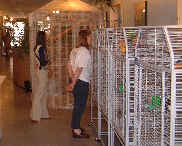
| Amazon Expedition Travel
|
 |
|
|
|

| User Functions
|
|
|
Don't have an account yet? Sign up as a New User
|
|

| Help support this site!
|
|
|
Help support this site... your donations are needed to support research, conservation, and rescue efforts.
|
|

|
 |
| Columbus Zoo Helps 1,000 Endangered African Grey Parrots Confiscated in Cameroon |
 |
Friday, February 26 2010 @ 01:24 PM UTC
Contributed by: MikeSchindlinger
Views: 33125
|
 Mon, 2/8/2010 - 11:19 AM - By Jennifer M. Wilson
Mon, 2/8/2010 - 11:19 AM - By Jennifer M. Wilson
 Powell, OH - More than 1,000 endangered African grey parrots were delivered to the Limbe Wildlife Center in Cameroon last week after being confiscated as part of a $1.5 million illegal shipment at the Douala Airport. Powell, OH - More than 1,000 endangered African grey parrots were delivered to the Limbe Wildlife Center in Cameroon last week after being confiscated as part of a $1.5 million illegal shipment at the Douala Airport.
The shipmentthat was scheduled to be loaded on to Ethiopian Airlineswas the largest on record and is the third major bust of African grey parrots in Cameroon in the past two years. The Last Great Ape Organization (LAGA), in conjunction with Cameroonian law enforcement officials, coordinated the bust. The parrots were destined for Kuwait International Airport and the Bahrain International Airport.
Limbe staff members are scrambling to treat the parrots, many of which are injured or ill. Forty-seven parrots were found dead at the bottom of the crates upon arrival and another 30 did not survive the first day.
It is crazy, said Limbe manager Simone de Vries. It makes you sick to see how the parrots were packed in the boxes, the weaker ones trampled by the strongest.
|
|
|
| Author probes the ways we mistreat parrots |
 |
Thursday, November 05 2009 @ 03:43 AM UTC
Contributed by: MikeSchindlinger
Views: 8604
|
 PAT MCCOID; pat.mccoid@thenewstribune.com
PAT MCCOID; pat.mccoid@thenewstribune.com
Published: November 9th, 2008 12:30 AM
 Mira Tweti heaps so much praise on parrots in Of Parrots and People that readers might want to bring one home. Thats exactly what she hopes to prevent. Mira Tweti heaps so much praise on parrots in Of Parrots and People that readers might want to bring one home. Thats exactly what she hopes to prevent.
Tweti reveals parrots to be human-like in their intelligence, vocabulary skills and social sensibilities traits that have doomed them to cages for centuries.
But the praise is prelude to 300 pages of investigative journalism aimed at discouraging parrot ownership.
Tweti explains why life in a cage is particularly miserable for parrots. She documents the cruelty of breeding operations and follows firsthand the chain of parrot possession from jungle to living room. Its not a pretty story.
Parrots, possibly descended from dinosaurs, have the intelligence of a 3- to 5-year-old human. They mate for life, grieve for lost flockmates, defend one another fiercely and bond strongly with humans.
|
|
|
| Birds can Dance! |
 |
Friday, May 01 2009 @ 03:12 AM UTC
Contributed by: Paul Brennan
Views: 7528
|
 Birds Can Dance, Experts (and Zany Videos) Reveal
Birds Can Dance, Experts (and Zany Videos) Reveal
Matt Kaplan for National Geographic News
April 30, 2009
His tastes may be sooo ten years ago, but the Backstreet Boys' smallest fan has helped scientists make an all-new discovery: Birds can dance.
And so far, they're the only known animals to display such rhythm.
Cats, dogs, and lab monkeys spend lots of time around human music. But no animal had ever been confirmed as moving to a beatleading to the common belief that animals ain't got rhythm.
For one of two new studies on animal dancing, Aniruddh Patel at the Neurosciences Institute in San Diego and colleagues worked with Snowball the parrot, which seems to love "dancing" to the likes of Queen and Backstreet Boys.
To test whether the sulphur-crested cockatoo was really keeping a beat, the scientists would change the music's temporepresented in these videos as "BPM" (beats per minute).
Not one to miss a beat, Snowball quickly picked up the new rhythms, stomping and head-bobbing in time.
|
|
|
| Mexico's Parrot Trade Exposed |
 |
Monday, April 27 2009 @ 12:52 PM UTC
Contributed by: Paul Brennan
Views: 9067
|
 Defenders Magazine
Defenders Magazine
Spring 2009
Mexico's Parrot Trade Exposed
Defenders of Wildlife fights to stop trafficking of wild birds
by Charles Bergman
Arms flailing and menace in her eyes, the woman charges me from behind a pile of cages. I heard her husband say something about giving her a cuchilloa knife.
"No photos!" she yells in Spanish. "Don't take photos! Get out of here!"
I back away slowly.
We are in Xochimilco, a lively, outdoor market in Mexico City, where this woman is running a puesto, or stand for selling animals. She has stacks of animals in cages all around her, like walls of living creatures. In her cages are yellow-cheeked Amazons and orange-fronted parakeetsnative Mexican parrots, caught in the wild. She doesn't want me to photograph them because they are illegal.
Juan Carlos Cantu, director of Defenders of Wildlife's Mexico office, has brought me here, along with Maria Elena Sanchez, president of Teyeliz, a Mexican conservation organization. For over a decade they have been fighting Mexico's illegal parrot trade. No one in the country knows more about it than these twonot the authorities, not even the traders. With support from Defenders of Wildlife, they have recently published the first comprehensive report on the problem, exposing the tricks of this trade. They brought me to Xochimilco to show me its dark and dirty secrets.
"This woman knows what she's doing is illegal," Cantu says. "That's why she's angry. Sellers often get violent."
When Cantu and Sanchez began their research, they already knew the illegal trade was huge. "We knew because we could see them for sale in the markets, like these parrots here," says Cantu. "But no one knew how big. Now we have numbersfor the first time."
According to the study, between 65,000 and 78,500 parrots are illegally trapped in the wild in Mexico every year, and thousands are smuggled across the border into the United States.
|
|
|
| Good News for Critically Endangered Parrot |
 |
Monday, February 23 2009 @ 08:17 PM UTC
Contributed by: Paul Brennan
Views: 6607
|
 The miraculous discovery of a male kakapo (Strigops habroptila), over twenty years after it was last seen has boosted the known world population of this Critically Endangered parrot to 91.
The miraculous discovery of a male kakapo (Strigops habroptila), over twenty years after it was last seen has boosted the known world population of this Critically Endangered parrot to 91.
BirdLife International reports that the flightless, nocturnal bird was recently rediscovered booming (the males unique, resonant mating call) where no kakapos had been detected before.
The bird had not been seen since 1987, when it was one of four males released onto a conservation sanctuary near Stewart Island, New Zealand. As well as giving the potential for introducing extra genetic material into the kakapo breeding programme, the find has raised hopes of discovering more kakapos on this and other islands.
|
|
|
| Home for parrots whose owners flew the coop |
 |
Saturday, November 01 2008 @ 11:38 AM UTC
Contributed by: MikeSchindlinger
Views: 38127
|
 A sanctuary for unwanted parrots
A sanctuary for unwanted parrots
(Boston Globe) Foster Parrots provides homes for birds that can no longer be taken care of by their owners. The birds are intelligent and social but become moreaggressive as they mature. By Joanne Rathe, Globe Staff / By Bina Venkataraman /Globe Correspondent / October 27, 2008
 The shrieks of Moluccan cockatoos ricochet off the walls in a cacophonous roar, while parakeets clamor "Hello! Hello!" to one another. At the New England Exotic Wildlife Sanctuary, more than 300 parrots take ambient noise to new heights. The shrieks of Moluccan cockatoos ricochet off the walls in a cacophonous roar, while parakeets clamor "Hello! Hello!" to one another. At the New England Exotic Wildlife Sanctuary, more than 300 parrots take ambient noise to new heights.
This is the first parrot sanctuary of its size and caliber in the country, said author Mira Tweti, who has studied the parrot trade for more than a decade. With aviaries that stretch more than 7,000 square feet, and an additional 5,000 square feet of flying space under construction, the sanctuary provides something that thousands of parrots lack: a permanent home.
Many of these former pet birds were shuffled from house to house for years before they landed here, and were adopted by Foster Parrots, a nonprofit group started by Marc Johnson, of Middleborough. The sanctuary lies on a 15-acre plot about 5 miles from the Connecticut border, in a single-story building that was once - oddly enough - the broiler house for a chicken farm. Since setting up shop in December, Johnson has been getting more and more calls from people hoping to unload their parrots.
|
|
|
|
 |

| Who's Online
|
|
Guest Users: 5
|
|

| Foster Parrots - Adoption and Conservation
|
|
|
|
|

| Vote
|
|
How many years have you lived with a parrot?
1854 votes | 0 comments
|
|

| Vote
|
|
Where does your parrot's species live? (Cast an additional vote for each bird you live with)
1307 votes | 3 comments
|
|

| Adopt a Parrot
|
 |
|
|
|

| Current Parrot News
|
|
|
Conservation Program Prepares Captive Parrots For Life In The Wild - Texas A&MJailbird Parrots Return to the Wild...As Fugitives - National Audubon SocietyThese parrots once roamed the American Southwest. Scientists are trying to help them : Short Wave - NPRDoes parrot farming protect wild species? Wildlife trade researchers review the evidence - The ConversationNew Study Urges Caution Over Growing Trade in Captive-bred parrots - World Animal ProtectionCritically endangered parakeets get a new home on New Zealand island - MongabayVantara reintroduces 41 extinct-in-the-wild Spixâs Macaws in Brazil - Nation ThailandThis unorthodox method is saving baby parrots from extinction - National GeographicTHE PARROT KING - National Audubon SocietyWorld Parrot Day: Wild Africa, World Parrot Trust call for stronger protection of parrots in Nigeria - EnviroNews NigeriaFinalists for 2025 Indianapolis Prize helping protect parrots, manatees, jaguars and more - IndyStar'Another record' expected as more captive-bred orange-bellied parrots released - Australian Broadcasting CorporationBreaking Chains, Saving Wings: Wildlife SOS-GSPCA and Forest Department Rescue Parrots from Captivity - Pune Times MirrorCelebrating World Parrot Day: Introducing the IUCN SSC Wild Parrot Specialist Group to Boost Global Parrot Conservation - International Union for Conservation of NatureFIU conservation scientists give trafficked, endangered parrots fighting chance - FIU NewsChinaâs plans to trace wildlife trade risks inflaming trafficking, critics warn - MongabayFor âextinctâ Spixâs macaw, successful comeback is overshadowed by uncertainty - MongabayCurrent protected areas not enough to save parrots from extinction: Study - MongabayUC student's parrot conservation work featured in new docuseries - University of CincinnatiSingaporeâs Wild Bird Trade Raises Troubling Questions About African Grey Parrots - WCS NewsroomRare orange-bellied parrot chick born at Victorian wildlife conservation park - Pulse TasmaniaAfrican grey parrots â cruel conservation concern and pandemic threat discovered in vodou markets - World Animal Protectionillegal trade in parrots punished with strong convictions - International Fund for Animal Welfare | IFAWCan We Conserve Endangered Parrots By Keeping Them In Cities? - ForbesSaving parrots in the illegal wildlife trade with DNA technology - Earth.comEUâs legal loophole feeds gray market for worldâs rarest parrot - MongabayTexas A&M Researchers Apply Free-Flight Training To Parrot Conservation - Texas A&MVideo: Thousands of illegally caught African gray parrots being rehabilitated - MongabayParrots - Defenders of WildlifeCelebrating World Parrot Day: Costa Rica's Commitment to Conservation and Awareness : - The Tico TimesArizonaâs Extirpated, Native Parrots - MeatEaterField Notes: Reinvigorating wild parrot populations with captive birds - MongabayTrade in African Grey Parrots for Belief-Based Use: Insights From West Africa's Largest Traditional Medicine Market - FrontiersSome of San Francisco's iconic wild parrots are sick. Meet the people who are saving them. - SFGATESaving the blue parrots of South America - BBC EarthUS Fish And Wildlife Provides Funding To Help Conserve The Puerto Rican Parrot - ForbesThe KÄkÄpĆ Parrot Returns To New Zealand - Science FridayJuan Carlos CantĂș - Defenders of WildlifeThere are 14 wild orange-bellied parrots left â this summer is our last chance to save them - The ConversationSaving flightless parrots from extinction - BBC Wildlife MagazineOrange-bellied parrot shows thereâs more to saving endangered species than captive breeding - The ConversationMore capacity building funds needed for small nonprofit conservation groups (commentary) - MongabayEcho parakeet management programme - ZSLGlobal trade in African grey parrots banned - Phys.orgSingapore's wild bird trade raises troubling questions about African grey parrots - Phys.orgSingaporeâs Wild Bird Trade Raises Troubling Questions About African Grey Parrots - Traffic.orgThis parrot was thought to be extinct in the wild â until a farmer spotted one - The Washington PostInternational trade in African grey parrots banned - MongabayAfrican grey parrot has global summit to thank for protected status | Illegal wildlife trade - The GuardianCritically Endangered Parrot Bounces Back in Huge Conservation Victory - ScienceAlertRare Parrots Rebound In New Zealand And Australia - WorldAtlasEndangered Neotropical Parrots Inform In Situ and Ex Situ - researchgate.netHabitat Preferences of the Grey Parrot in Heterogeneous Vegetation Landscapes and Their Conservation Implications - Wiley Online LibraryConservation Concern for the Deteriorating Geographical Range of the Grey Parrot in Cameroon - Wiley Online LibraryFlorida's Wild Parrots Are Being Poached, Sold On the Internet, and It's Perfectly Legal - The Weather ChannelParrots Seized from Congolese Traffickers in April 2022 released to the wild - Modern GhanaHow hobby bird breeders believe they can help save endangered parrots - Australian Broadcasting CorporationHopes of saving orange-bellied parrot hang on foster baby - Australian Broadcasting CorporationUWEC releases back into the wild rehabilitated African grey parrots - Nilepost NewsForest conservation: Saving the endangered Cape parrotâs natural habitat by planting one tree at a time - Daily MaverickDonât give up on orange-bellied parrots yet, thereâs still hope - The ConversationUWEC unveils African Grey Parrot Conservation Center - ChimpReportsWorld Sensation: Return of a Parrot Species Extinct in the Wild â Project Updates - lifePRParrots Seized from Congolese Traffickers Released to the Wild - SoftPower NewsWorld sensation: Return of a parrot species extinct in the wild - lifePREarth Wire -- Global trade in wild African Grey Parrot banned, U.N. meeting rules - ANTARA NewsUWEC opens Ugandaâs first grey parrot conservation centre - Daily MonitorUganda releases parrots seized from Congolese traffickers - PML Daily
|
|

|
|

|

